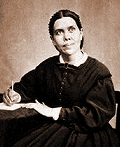|
The Shekinah had departed from the sanctuary, but in the Child of Bethlehem
was veiled the glory before which angels bow. This unconscious
babe was the promised seed, to whom the first altar at the gate of Eden pointed.
This was Shiloh, the peace giver. It was He who declared Himself to Moses as the
I AM.13 It was He who in the pillar of cloud and
of fire had been the guide of Israel. This was He whom seers had long foretold.
He was the Desire of all nations, the Root and the
Offspring of David, and the Bright and Morning Star. The name of that helpless
little babe, inscribed in the roll of Israel, declaring Him our brother, was the
hope of fallen humanity. The child for whom the redemption money had been paid was
He who was to pay the ransom for the sins of the whole world. He was the true
"high priest over the house of God," the head of
"an unchangeable priesthood," the intercessor
Page 55
at "the right hand of the Majesty on
high."14 Heb. 10:21; 7:24; 1:3.
|
In the light of this explanation, let us
look yet once again at our Lord's presentation in the temple as a
first-born child, and see whether—as the eye of faith looks
through the outward actions to that which the actions symbolize,
looks through the outward form and discerns the spiritual
significance—the whole scene does not become, as it were,
transfigured before us. You mount the steps, and come up into this
temple at Jerusalem. It is neither a feast-day nor a Sabbath-day,
nor is it the fixed hour for prayer. A few priests, or Levites, or
other hangers-on of the holy place are loitering in the outer
courts. A man and a woman in Galilean dress, the woman bearing an
infant in her arms, cross the court and go forward to where the
priest is standing, whose duty it is to present whatever individual
sacrifices or oblations may that day be offered. They tell the
priest their errand, hand to him or to one of his attendants the
two young
page 35
turtle-doves and the five shekels of the sanctuary. He in his turn
goes through with his part of the prescribed ceremonial, and gives
the child back again to his parents as a first-born child that had
been devoted to the Lord. The father, the mother, the priest,
whatever onlookers there are, all imagine that nothing more has
been done in all this than is so often done when first-born
children are consecrated. But was it so? Who is this child that
lies so passive on its mother's breast, and all unconscious of what is being done with him, is
handled by the officiating priest? He is, as his birth had
proclaimed him to be, one of the seed of Abraham, and yet he
afterwards said of himself, "Before Abraham was I am."13,
15
He is, as the
angel had proclaimed him to be, David's son and David's heir; but
as he said afterwards of himself, the
root as well as the branch of David:
David's Lord as well as David's son.16
He is the first-born of Mary, but he is
also the first-born of every creature, the beginning of the
creation of God. He is the infant of a few weeks old, but also
the Ancient of Days, whose goings forth were from of old, from
everlasting. Here then at last is the Lord, the Jehovah, whom
so many of the Jews were seeking, brought suddenly, almost, as one
might say, unconsciously into his own temple.16
Here is the Lamb of
God, of old provided, now publicly designated and
set apart—of which the paschal one, the sight of whose blood
warded off the stroke of the destroying angel, was but the
imperfect type.16
Here is the one and
only true High Priest over the house of God, consecrated to
his office, of whose all prevailing, everlasting, and
unchangeable priesthood, the Aaronic
priesthood, the priesthood of the
first-born, was but the dim shadow.15 Here is the Son
presented to
the Father, within the holy place on earth, as he enters upon that
life of service, suffering, sacrifice, the glorious issue of
which was to be his entering not by the blood of bulls and
goats, but by his own blood, into that holy place not made with
hands, having obtained eternal redemption for
us, there for ever to present himself
before the Father, as the living head of the great community
of the redeemed, the general assembly and church of the
first-born which are written in
heaven.
|
And having an high priest over the house of God. (Heb. 10:21)
But this man, because he continueth ever, hath an
unchangeable priesthood. (Heb. 7:24)
I Jesus have sent mine angel to testify unto you these things in the churches.
I am the root and the offspring of David, and the bright and morning star. (Rev. 22:16)
|


